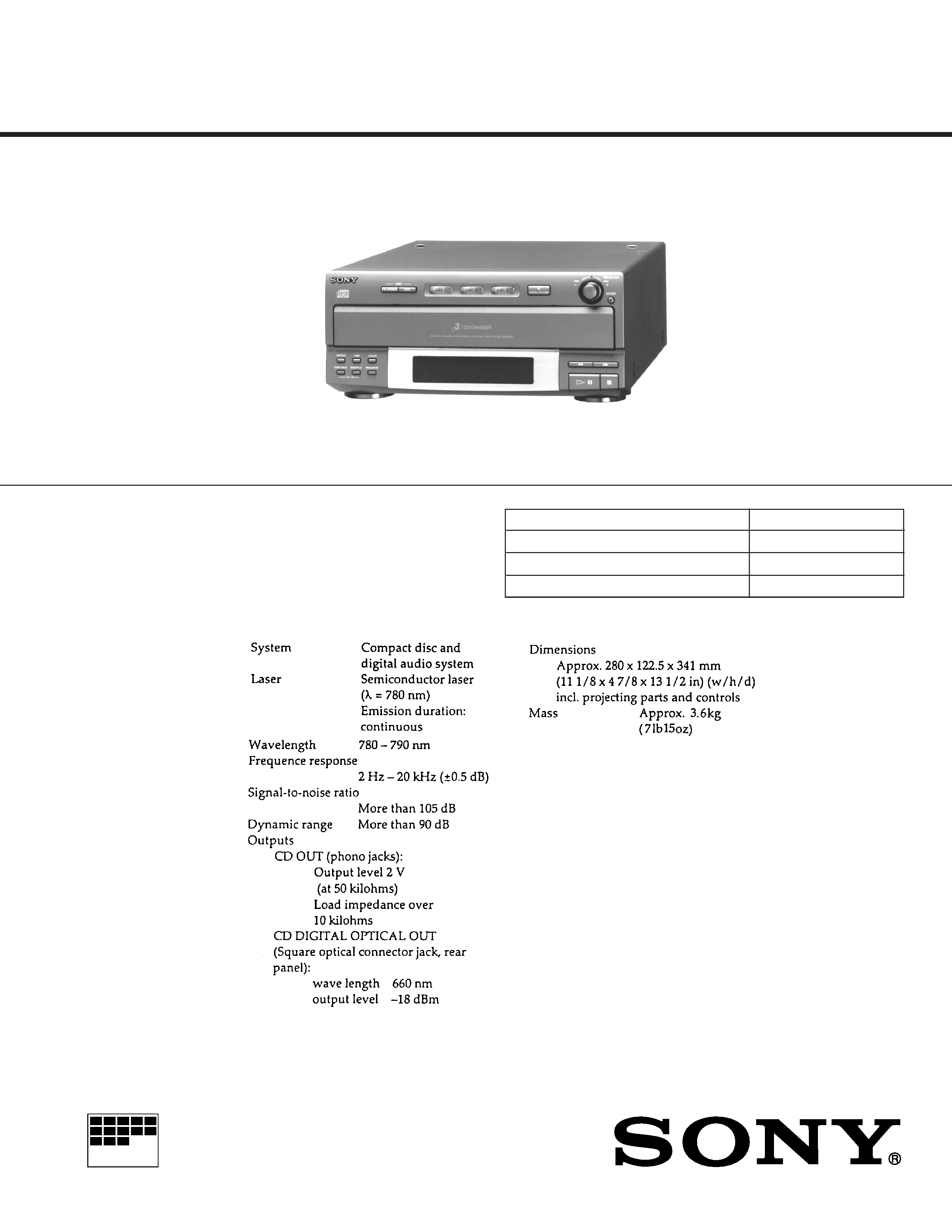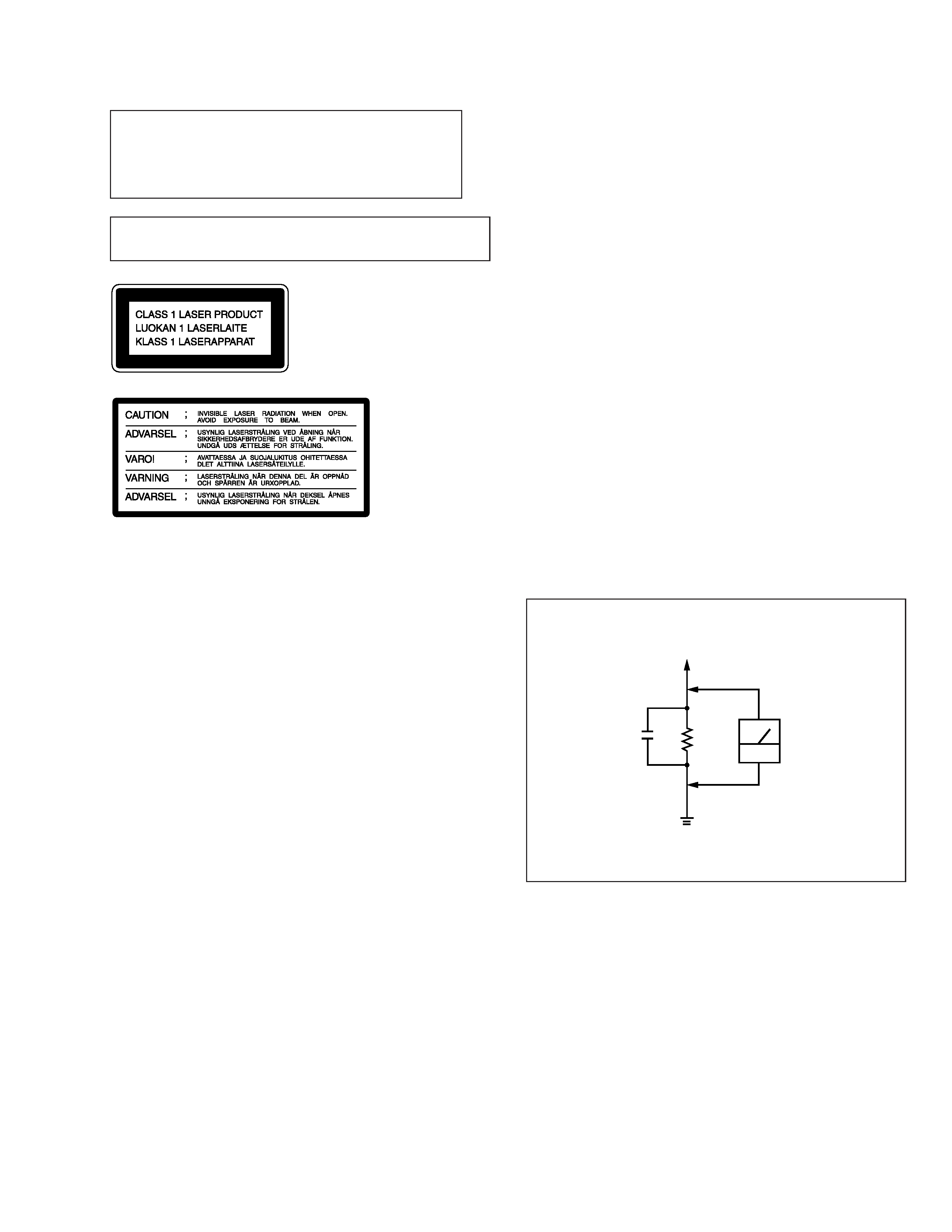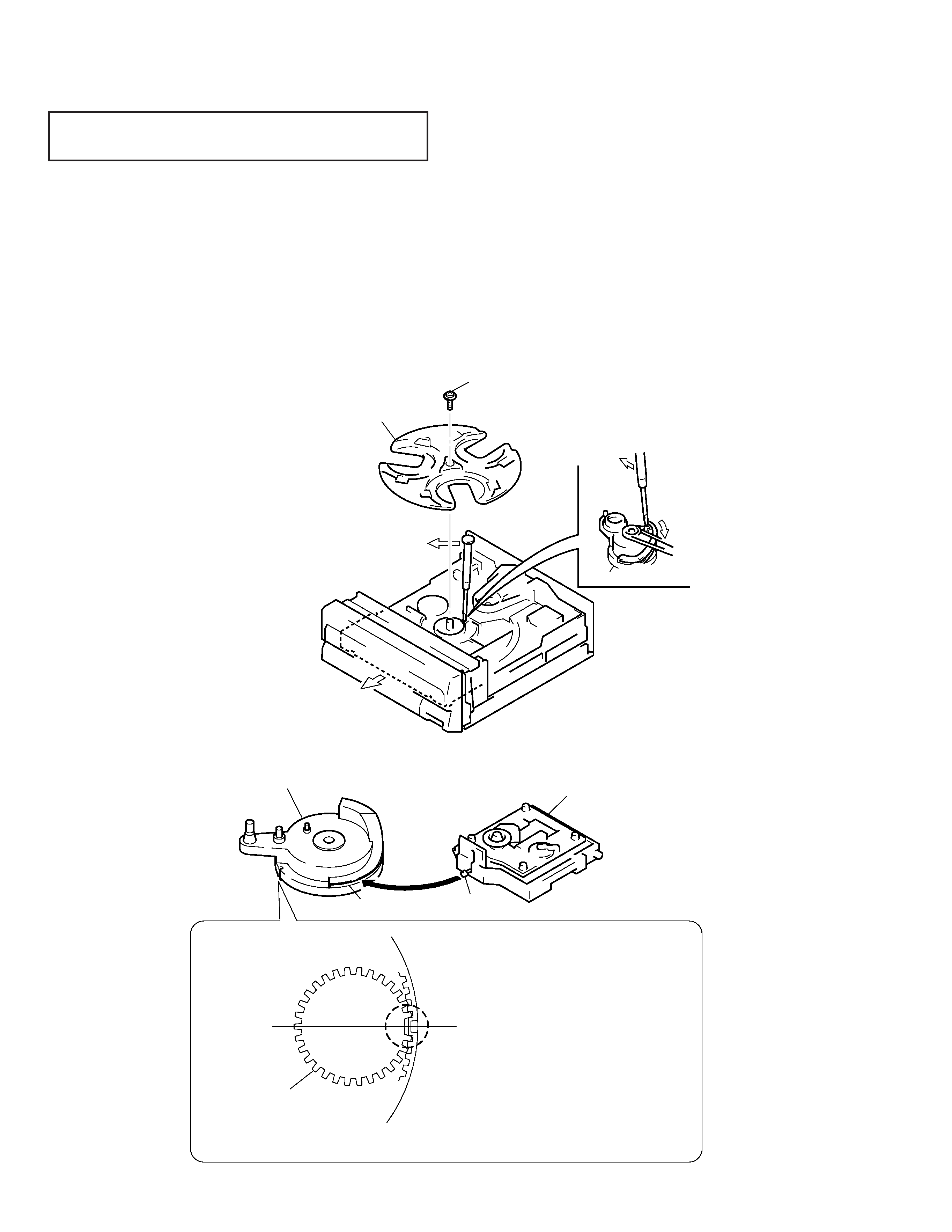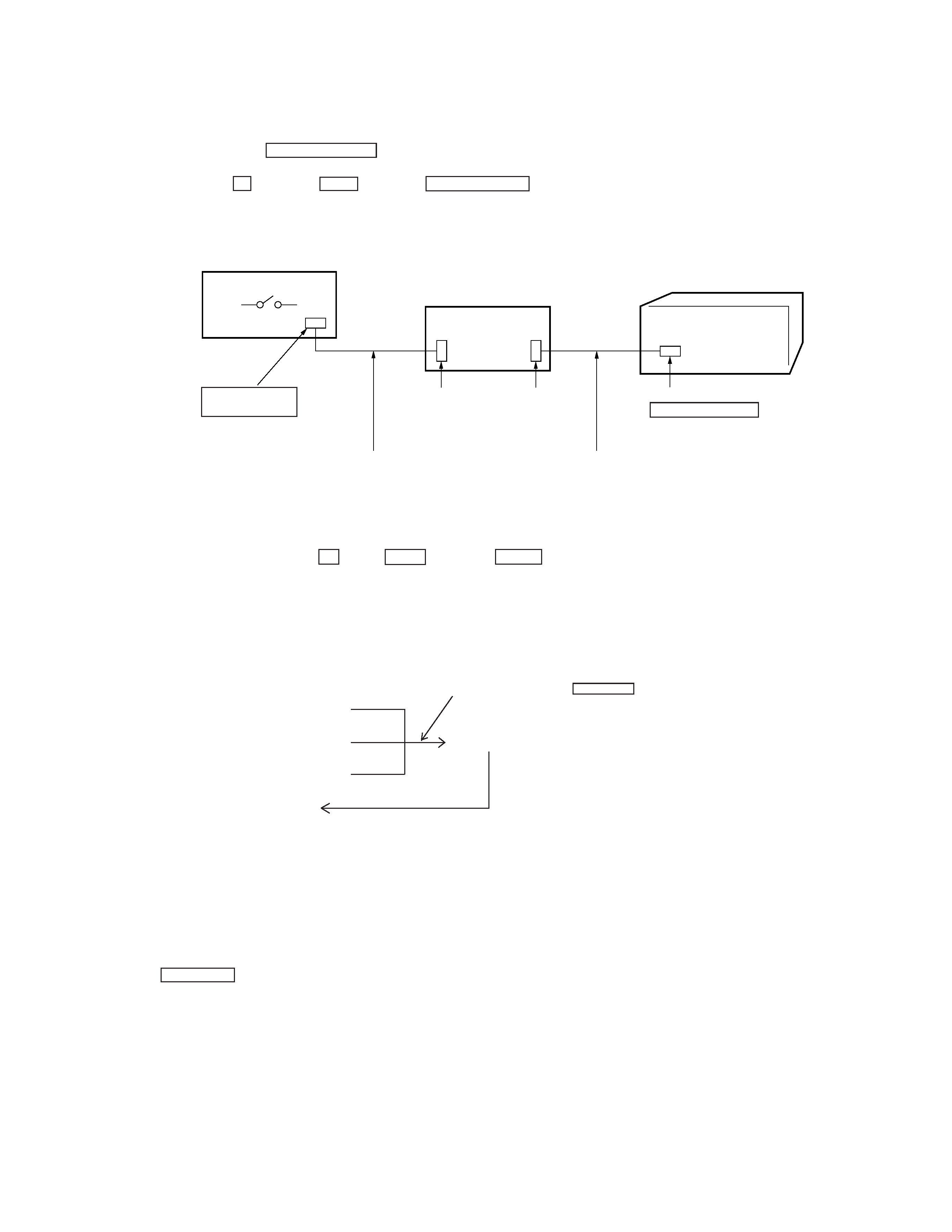
-- 1 --
COMPACT DISC PLAYER
SERVICE MANUAL
Model Name Using Similar Mechanism
NEW
CD Mechanism Type
CDM38A-5BD19
Base Unit Type
BU-5BD19
Optical Pick-up Type
KSS-213B/K-N
MICROFILM
CDP-M7
US Model
Canadian Model
E Model
Tourist Model
SPECIFICATIONS
Design and specifications are subject to change without notice.
CDP-M7 is the CD player section
in DHC-MD7.

-- 2 --
TABLE OF CONTENTS
1. SERVICING NOTE ...................................................... 4
2. GENERAL .................................................................... 6
3. DISASSEMBLY
3-1.
Case, Front Panel Assembly and Chassis ........................... 7
3-2.
Back Panel and Tray ........................................................... 7
3-3.
Main Board and Connector Board ...................................... 8
3-4.
Base Unit ............................................................................ 8
4. ELECTRICAL ADJUSTMENT .................................. 9
5. DIAGRAMS
5-1.
Circuit Boards Location ................................................... 11
5-2.
IC Pin Function
· IC501 System Control (µPD780205GF-016-3BA) ....... 12
5-3.
IC Block Diagrams -- BD Section -- ............................. 14
5-4.
Schematic Diagram -- Main Section -- .......................... 16
5-5.
Printed Wiring Board -- Main Section -- ....................... 21
5-6.
Printed Wiring Board -- Panel Section -- ....................... 24
5-7.
Schematic Diagram -- Panel Section -- .......................... 27
5-8.
Schematic Diagram -- BD Section -- ............................. 30
5-9.
Printed Wiring Board -- BD Section -- .......................... 33
6. EXPLODED VIEWS
6-1.
Front Panel Section .......................................................... 35
6-2.
Back Panel and Disc Table Section .................................. 36
6-3.
Mechanism Dick Section (CDM38A-5BD19) ................. 37
6-4.
Base Unit Section (BU-5BD19) ....................................... 38
7. ELECTRICAL PARTS LIST .................................... 39
MODEL IDENTIFICATION
-- BACK PANEL --
4-977-697-2
4-977-697-1
US,Canadian model
Other model
PARTS No.
Parts No.

-- 3 --
Laser component in this product is capable of emitting radiation
exceeding the limit for Class 1.
This appliance is classified as a
CLASS 1 LASER product.
The CLASS 1 LASER PRODUCT
MARKING is located on the rear
exterior.
CAUTION
Use of controls or adjustments or performance of proce-
dures other than those specified herein may result in haz-
ardous radiation exposure.
This caution label
is located inside
the unit.
Notes on chip component replacement
· Never reuse a disconnected chip component.
· Notice that the minus side of a tantalum capacitor may be
damaged by heat.
To Exposed Metal
Parts on Set
1.5k
AC
voltmeter
(0.75V)
Earth Ground
Fig. A. Using an AC voltmeter to check AC leakage.
0.15µF
SAFETY CHECK-OUT
After correcting the original service problem, perform the following
safety checks before releasing the set to the customer:
Check the antenna terminals, metal trim, "metallized" knobs, screws,
and all other exposed metal parts for AC leakage. Check leakage as
described below.
LEAKAGE
The AC leakage from any exposed metal part to earth ground and
from all exposed metal parts to any exposed metal part having a re-
turn to chassis, must not exceed 0.5 mA (500 microampers).
Leakage current can be measured by any one of three methods.
1. A commercial leakage tester, such as the Simpson 229 or RCA
WT-540A. Follow the manufacturers' instructions to use these
instruments.
2. A battery-operated AC milliammeter. The Data Precision 245
digital multimeter is suitable for this job.
3. Measuring the voltage drop across a resistor by means of a VOM
or battery-operated AC voltmeter. The "limit" indication is 0.75
V, so analog meters must have an accurate low-voltage scale. The
Simpson 250 and Sanwa SH-63Trd are examples of a passive
VOM that is suitable. Nearly all battery operated digital
multimeters that have a 2V AC range are suitable. (See Fig. A)
SAFETY-RELATED COMPONENT WARNING !!
COMPONENTS IDENTIFIED BY MARK
! OR DOTTED
LINE WITH MARK
!ONTHE SCHEMATIC DIAGRAMS AND
INTHE PARTS LIST ARE CRITICAL TO SAFE OPERATION.
REPLACE THESE COMPONENTS WITH SONY PARTS
WHOSE PART NUMBERS APPEAR AS SHOWN IN THIS
MANUAL OR IN SUPPLEMENTS PUBLISHED BY SONY.
ATTENTION AU COMPOSANT AYANT RAPPORT
À LA SÉCURITÉ!!
LES COMPOSANTS IDENTIFIÉS PAR UNE MARQUE
!SUR
LES DIAGRAMMES SCHÉMATIQUES ET LA LISTE DES
PIÈCES SONT CRITIQUES POUR LA SÉCURITÉ DE
FONCTIONNEMENT. NE REMPLACER CES COMPOSANTS
QUE PAR DES PIÈCES SONY DONT LES NUMÉROS SONT
DONNÉS
DANS
CE
MANUEL
OU
DANS
LES
SUPPLÉMENTS PUBLIÉS PAR SONY.

-- 4 --
NOTES ON LASER DIODE EMISSION CHECK
The laser beam on this model is concentrated so as to be focused on
the disc reflective surface by the objective lens in the optical pick-up
block. Therefore, when checking the laser diode emission, observe
from more than 30 cm away from the objective lens.
SECTION 1
SERVICE NOTE
NOTES ON HANDLING THE OPTICAL PICK-UP BLOCK
OR BASE UNIT
The laser diode in the optical pick-up block may suffer electrostatic
break-down because of the potential difference generated by the
charged electrostatic load, etc. on clothing and the human body.
During repair, pay attention to electrostatic break-down and also use
the procedure in the printed matter which is included in the repair
parts.
The flexible board is easily damaged and should be handled with
care.
Note For Installation (ROTARY ENCORDER (S811))
How To Open The Disc Tray When Power Switch Turns Off
1 Refer to 3-1. to remove the case.
BU cam
groove
Note: When attaching the BU
cam, engage the Rotary
encorder switch as
shown in the figure.
A
3 Yoke bracket
2 Tray (TURN)
Insert the screwdriver (flat-blade) into the tray
(SLIDE), tilt the screwdriver (flat-blade) in the
direction of arrow A and move the BU cam
assembly in the direction of arrow B to open
the tray (SLIDE).
A
A
B
BU cam assembly
Base unit
Rotary encorder
Note: When attaching the Base unit, insert the
section A into the groove of BU cam.

-- 5 --
Power Supply During Servicing
This unit is not able to operate on its own because it does not have its own power supply. During servicing, connect to other units.
Power is supplied when the SYSTEM POWER button of the amplifier (TA-M7) is turned ON.
If the other units are not available, use a service box (PFJ-1) and jig (J-2501-078-A).
In this case, press the
p button and TIME button and §OPEN/CLOSE button simultaneously to turn on the power.
[Connection Diagram]
Fluorescent Indicator Tube/Key Check Mode
After turning on the power, press the
p button, TIME button, and DISC 1 button simultaneously to perform the Fluorescent indicator tube
check.
The steps of the Fluorescent Indicator Tube check mode will proceed onto the next one by the above multiple pressing.
During the Fluorescent Indicator Tube check mode, press any button or rotate the selector knob to set the key check mode.
To end the mode, press the above three buttons simultaneously.
Key check mode
Press any key or rotate the SELECTOR knob
Multiple pressing
Multiple pressing
Multiple pressing
Multiple pressing
SERVICE BOX (PFJ-1)
POWER SW
JIG
(J-2501-078-A)
CN904
17P
CN902
7P
CN101 7P
SYSTEM CONTROL
FH-E939,838,937
CDP/TC
CORD WITH CONNECTOR 17P
(Provided with PFJ-1)
CORD WITH CONNECTOR 7P
(Provided with unit)
Note 1)
When the three buttons pressed to enter the Fluorescent Indicator Tube all lit mode are released together, the Fluorescent Indicator
Tube all lit mode will remain on. When released separately, the key check mode will be set soon after the Fluorescent Indicator Tube
all lit mode.
In `'multiple pressing", if the three buttons are pressed and released together, the next mode will be set. If not, the key check mode will
be set.
Note 2)
In the key check mode, each time the button is pressed, the "KEY=" number on the Fluorescent indicator tube increases. When the
SELECTOR knob is rotated, the "KEY=" number on the Fluorescent indicator tube increases in the + direction and decreases in the
direction.
Fluorescent Indicator Tube all lit mode
µ
Segment pattern 1 mode
µ
Segment pattern 2 mode
µ
End of test mode
UNIT (CDP-M7)
